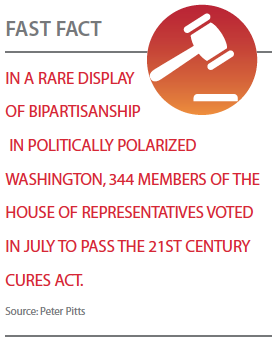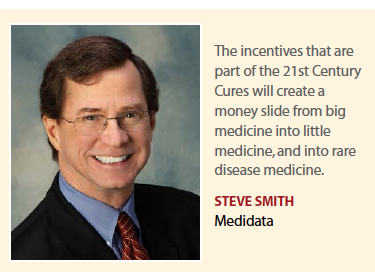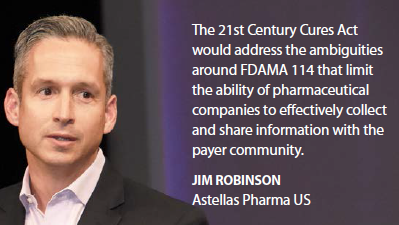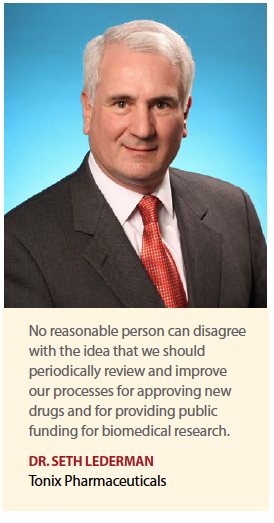The 21st Century Cure Act, if passed, promises to promote the development and hasten the approval of new drugs and devices, especially treatments for cancer and rare diseases. It puts the view of the patient in the center of drug discovery, development, and delivery, balanced by insights derived from data analytics, clinical science, and a more flexible approval process. Clinical research provisions minimize unnecessary and duplicative administrative requirements, and to promote the broad availability of clinical research data, with adequate security and privacy measures, to advance medical product innovation. The bill also contains a provision to facilitate and encourage investigating treatments for rare diseases in clinical research.
 The House overwhelmingly passed its version of the bill in July of this year and the Senate is reviewing its draft — called the Innovation for Healthier Americans — and plans to make it public for review in early fall. (For summaries of the House’s bill provisions, see bonus digital copy.)
The House overwhelmingly passed its version of the bill in July of this year and the Senate is reviewing its draft — called the Innovation for Healthier Americans — and plans to make it public for review in early fall. (For summaries of the House’s bill provisions, see bonus digital copy.)
Naysayers of the initiative raise concerns regarding patient safety, saying the act goes too far in pushing the FDA to speed up the drug approval process, and that the existing protocol is adequate and presents less of a risk to consumers.
According to reports from Dr. Janet Woodcock, director of the FDA’s Center for Drug Evaluation and Research, those who say that the 21st Century Cures legislation lowers the standard of safety “are completely wrong." Steve Smith, chief patient advocate, Medidata, quotes her directly from her presentation at the DIA annual meeting in Washingon, D.C., in June, where he asked her to clarify her remarks.
“Dr. Woodcock, who has taken the lead for the FDA in discussing the bill, said the FDA would be the first to protest if the act did compromise safety; she has said unequivocally that the 21st Century Cures bill is a good bill," Mr. Smith says. “Dr. Woodcock clearly said it does not compromise safety and it does not lower the standard of efficacy that the FDA must uphold."
 According to Max Bronstein, senior director, advocacy and science policy, EveryLife Foundation for Rare Diseases, the bark from safety watchdogs is not new, and has been clearly addressed by the FDA.
According to Max Bronstein, senior director, advocacy and science policy, EveryLife Foundation for Rare Diseases, the bark from safety watchdogs is not new, and has been clearly addressed by the FDA.
“We’ve heard concerns like this before," Mr. Bronstein says. “Detractors should listen to Dr. Woodcock, to Acting FDA Commissioner Dr. Stephen Ostroff, and to two former FDA Commissioners, Dr. Mark McClellan and Dr. von Eschenbach. They’ve all gone on record saying the 21st Century Cures Act will not affect the safety standards that the FDA has put in place in its mandate for safety; it will not have any impact on safety whatsoever."
The EveryLife Foundation for Rare Diseases, a nonprofit organization dedicated to accelerating biotech innovation for rare disease treatments, has initiated efforts to nullify such fears, but opponents to the bill seem to be getting more press than the advocates.
“The media has featured dissenting voices, and while they are in the small minority, they tend to get quite a bit of airtime on the issue, so it’s not as balanced a debate as it could or should be," Mr. Bronstein says.
With 7,000 untreated rare diseases and only 400 treatments for rare diseases, the need for such a bill is apparent to its advocates. Advances in science and technology, such as personalized medicine, are creating new opportunities to improve and expand research into rare diseases and the development of new treatments.
The act expedites research and development for a wide variety of debilitating illnesses, and makes it easier to get new treatments to patients who need them.
“The 21st Century Cure Act is one of several developments that I envision will usher in a more collaborative, patient-centric approach to develop new and innovative therapeutics, particularly in rare diseases," says Gene Kinney, Ph.D., chief scientific officer and head of research and development, Prothena.
“In these settings, where the successful regulatory and clinical approaches are typically undefined, it can be challenging," Dr. Kinney says. “As such, it’s more important than ever to integrate patient insights into the earliest stages of drug development."
Advocacy groups — such as EveryLife Foundation for Rare Diseases — are an effective driver of engagement between patients, researchers, clinicians, and industry, enabling better design of clinical programs, sharing of scientific research, and the creation of educational disease awareness. Such collaboration should result in new treatments that demonstrably improve health outcomes, a win for both the patient and the health system as a whole, Dr. Kinney says.
This type of stakeholder collaboration has already been forged through the passing of the act through the House.
 “The 21st Century Cures Act has been a remarkably galvanizing process," says Jim Robinson, president, Astellas Pharma US. “The collaborative spirit forged by Chairman Upton and Congresswomen DeGette, coupled with the parallel efforts being shepherded in the Senate by HELP Committee Chairman Alexander, is an admirable rallying cry that evidences bi-partisan support for the need to advance the discovery and development of innovative new therapies and treatments into the 21st century and one that the industry hopes will extend beyond this singular initiative."
“The 21st Century Cures Act has been a remarkably galvanizing process," says Jim Robinson, president, Astellas Pharma US. “The collaborative spirit forged by Chairman Upton and Congresswomen DeGette, coupled with the parallel efforts being shepherded in the Senate by HELP Committee Chairman Alexander, is an admirable rallying cry that evidences bi-partisan support for the need to advance the discovery and development of innovative new therapies and treatments into the 21st century and one that the industry hopes will extend beyond this singular initiative."
Proponents are waiting impatiently for the Senate to publish its version, because time is of the essence with the upcoming election year bearing down on the bill’s shelf life.
“One of our big concerns about the Senate initiative is that we haven’t seen any draft legislation yet, and the Senate has a lot of distractions coming up," Mr. Bronstein says. “There’s a presidential election that’s starting to heat up, so if the Senate doesn’t act on this bill this year, all the good work that was done by the House and all of the stakeholders and patients who were engaged in the process might be for nothing if the Senate doesn’t make this a priority."
If the bill does not reach or is not approved by this administration, the initiative would have to start all over, which would be a shame, Mr. Smith says, as there has been so much time and effort put into the bill so far.
“There has been such a thorough listening and information gathering process starting in House of Representatives that we’re not going to get to this point again easily if the bill doesn’t make it all the way through by the end of 2016," he says.
To help nudge the process along, the EveryLife Foundation for Rare Diseases took advantage of the captive audience at the Global Genes Conference and asked everyone in attendance to contact their senators. The group provided phone numbers and e-mails and a script and many attendees took action right then and there.
“We let all the folks know that when it comes to issues like funding for the NIH and FDA, the Senate needs to move on because quite frankly, a delay in legislation is going to delay treatment for patients," Mr. Bronstein says. “And if you’re a patient who has a rare disease or any life-threatening disease, you do not have the luxury of time. The Senate has to take action, otherwise, we could miss this great window of opportunity."
Provisions in the Bill
The 21st Century Cures Act is large and complex — even though it has been cut in half by 200 pages from its original incarnation earlier this year — and its passing will have wide ranging implications across all healthcare stakeholders, not the least of whom are patients.
In addition to increasing medical research funding and expediting the process of making breakthrough therapies available to patients, if enacted into law, the bill would impose significant new requirements related to the regulation of health information technology. The bill includes several provisions related to federal oversight of clinical research, as well as provisions for Medicare and Medicaid, and several FDA-related changes.
The complexity of the legislature makes it difficult for all to agree, which is adding to the anxiety of those who believe that the act is paramount to better healthcare in this country and needs to be made into law as soon as possible.
The two predominant sections propose to change the processes by which U.S. regulators approve new medicines and spend public funds for research. Not many can argue with the need for more funding to further research by the NIH, but not everyone is onboard with changing the FDA drug approval process.
 According to Seth Lederman, M.D., co-founder, CEO, and chairman of Tonix Pharmaceuticals, the two processes are not equally in need of fixing. Dr. Lederman believes the U.S. approval process of new medicines is appropriate, but that the NIH could use the boost of funds for further investigative trials for cancer research.
According to Seth Lederman, M.D., co-founder, CEO, and chairman of Tonix Pharmaceuticals, the two processes are not equally in need of fixing. Dr. Lederman believes the U.S. approval process of new medicines is appropriate, but that the NIH could use the boost of funds for further investigative trials for cancer research.
“In my opinion, the relative health of FDA and the relative dysfunction of NIH/NCI should be strongly considered in selecting the potency and potential risks of any intervention," he says. “The FDA’s independence from political pressure is of paramount importance. In contrast, the NIH/NCI appears to need new systems of oversight, hopefully involving patients. I believe that a rededication of NIH/NCI to the unique mission of funding investigator-initiated basic research makes economic sense given the restricted funds currently available."
In contrast to the FDA, the health of the NIH/NCI system for providing funding for biomedical research is strained and there is widespread dissatisfaction among most of the participants, Dr. Lederman adds.
He adds that the funding constraints of “sequestration" have strangled the initiative to transform NIH/NCI from a basic research funding organization into a platform to discover and develop new drugs and compete with the private sector biopharmaceutical companies.
“Given the financial constraints, I would favor a rededication of the NIH/NCI back to funding basic research, with an emphasis on investigator-initiated research," Dr. Lederman says.
Despite his concerns, Dr. Lederman believes there is always a need to review new ways of doing things, and to discourage innovation through legislation does not bode well for the industry or the nation’s healthcare.
“Given the U.S.’s global leadership in developing new medicines, no reasonable person can disagree with the idea that we should periodically review and improve our processes for approving new drugs and for providing public funding for biomedical research," Dr. Lederman says.
Increased funding for the NIH and the FDA is crucial to the discovery of new treatments and is an important part of the bill, Mr. Smith says.
“The new law would direct funding to the NIH and the FDA, which has been declining since 2000," he says. “This law calls for additional funding for the NIH, which provides very critical medical research.
Funding for the FDA means that the agency is going to be able to do a better job stepping up to the mandates that this legislation actually requires of regulators and some recent past legislations, such as 2012 PDUFA V, which is also called the FDA Safety and Innovation Act."
Communications
Another provision would also allow the FDA to communicate with necessary parties to learn more about a drug’s effectiveness, without being called out for being influenced by those discussions.
“A lot of good discussions, which need to happen, are being blocked by old-fashioned rules," Mr. Smith says. “We will start to see some of these behaviors change in the next few years. The FDA staff needs to be able to interact and be able to attend conferences and talk to whoever they need to talk to — people at pharmaceutical companies, physicians, and patients."
Mr. Robinson from Astellas Pharma is focused on the provisions that increase responsible communications of scientific and medical information by the industry to healthcare professionals and payers. For example, one provision in the bill would enable pharmaceutical companies to share pharmacoeconomic data with payers responsible for making coverage or reimbursement decisions.
Section 114 of the FDA Modernization Act of 1997 was intended to establish a pathway that allowed pharmaceutical companies to provide healthcare economic information to a formulary committee or other similar entity.
“However, the FDA has not provided formal guidance on its interpretation of the law and litigation on this provision has not resulted in any greater clarity," Mr. Robinson says.
“Payers want to know more about the value of the pharmaceutical products that they are allowing access to — not just the cost — and they are seeking such data," he says. “These lingering ambiguities around FDAMA 114 have limited the ability of pharmaceutical companies to effectively collect and share such information with the payer community."
The 21st Century Cures Act would address this situation, allowing payers access to information that could help them make more informed, efficient judgments, ultimately leading to better value overall for the healthcare system, improved quality of care provided, and improved patient outcomes.
Another provision would address communication between industry and physicians. The FDA would be required to issue draft guidance on pharmaceutical companies’ ability to communicate accurate, non-misleading, scientific information on approved medications. According to Mr. Robinson, better clarity in this regard could enable companies to provide physicians with much-needed information on certain medically accepted alternative uses of medicines.
“These provisions represent encouraging steps forward, and I hope the Senate, in its parallel efforts to craft companion legislation to the 21st Century Cures Act, continues to focus on ways to facilitate the development and delivery of important data and information that has the potential to improve the quality of care provided and patient outcomes through a more and better informed healthcare delivery system, which includes payers, providers and patients," Mr. Robinson says.
Clinical Trials
The act will also directly impact clinical trials, modernizing them by allowing the use of technology throughout the process.
“The act will speed clinical trials, make them safer, and make them more effective," Mr. Smith says. “It’s going to enable us to use more of our modern technology. It’s going to enable us to use more patient data — such as patient experience data, patient’s descriptions of their risk versus benefit tolerance — in ways we have not been able to do before. It’s going to enable us to use unstructured data more. It’s going to reduce the uncertainty in the use of applications and new kinds of devices such as mHealth devices. It’s going to increase the use of software and other technologies, which there’s a lot of hesitation to use today, especially the mHealth devices and apps. The legislation will remove all the fear and uncertainty and obstacles around these devices and apps. Even if the bill doesn’t pass in 2016, the fact that it was born out of such a strong desire from all stakeholders means it will happen someday."
To prepare for the possibility of the legislation becoming law in 2016, drug makers will want to implement cutting-edge systems and technology to design and run clinical trials and collect data in new ways. Adaption to these types of systems has already begun, spurred on by the 2012 FDA Safety and Innovation Act but the 21st Century Cures Act strengthens these provisions, such as the breakthrough therapy designation: the FDA will grant breakthrough therapy designation to a product as long as ongoing data can be captured, updated, analyzed, and communicated with the FDA during ongoing clinical trials. Companies will want to have these abilities in place in order to streamline the drug approval process.
Organizations will also want to be up to date with data collection procedures, as the FDA will be putting more pressure on the value and efficiency of the data collected, looking for high-quality and efficient data collection during the breakthrough therapy process.
“Efficiency and accuracy will become key, as companies won’t want to make data mistakes if they are applying for a breakthrough therapy designation," Mr. Smith says.
OPEN Act and Incentives
Under the act, the FDA will be mandated through the legislation to develop processes for validating biomarkers. Right now biological evidence inside the human body is under-utilized as evidence in clinical trials. Within the bill, there is language that would require the FDA to release guidance around biomarker qualification. This would mean the end point for whether a treatment is working or not could be determined earlier in the trial, by using biomarkers as surrogate endpoints. Instead of using life expectancy as the only measurement, biological factors can be monitored in shorter time periods.
“This is really a game changer because suddenly we can greatly accelerate the pace of a clinical trial," Mr. Bronstein says. “This is huge for those patients with rare diseases, because trials can be conducted faster and much more cost-efficiently, and suddenly we’re not talking about getting these patients a treatment in 20 to 30 years; we are talking about moving potential treatments forward in a much shorter time period."
Another provision in the act that would benefit the rare disease patient population is the Orphaned Product Extensions Now Accelerating Cures & Treatment or OPEN Act within the 21st Century Cures Act.
In short, the OPEN Act creates an incentive for industry to repurpose existing drugs for a rare disease indication. It’s modeled on the Best Pharmaceuticals for Children Act, and that law provides incentives to study the impact of drugs in children. This law is widely seen as very successful and very effective in terms of creating labeling changes for children’s medications.
“So right now there are about 400 treatments for rare diseases and we think the OPEN Act, if it becomes law, could actually double the number of treatments that are available for rare disease patients," Mr. Bronstein says. “We see this as hugely important for patients and obviously this has implications for industry as well because if companies are able to get that six-month exclusivity extension, this will have big implications for the bottom line."
The incentive could make repurposing for orphan drugs a very common occurrence, which is a win-win for patients and the industry.
“The reason these incentives are good is that they make the money slide from big medicine into little medicine into rare disease medicine," Mr. Smith says. “The money that’s moving from big drugs to rare disease drugs is coming from the private sector. There’s no government spending at all. All we need the government to do is allow the incentive."
Overall, the act will directly impact the development of all medicines, but especially those for rare diseases.
“Medical science has made tremendous advances in many areas, but huge unmet needs still remain complex diseases such as Alzheimer’s disease, Parkinson’s and a multitude of rare diseases," Dr. Kinney of Prothena says. “Many companies have invested in the development of drugs for rare diseases in recent years to address the needs of patients, but also incentivized by the Orphan Drug Act and the 21st Century Cures Act. I believe that we will see more innovations that can address not only rare disease, but also new approaches that target remaining unmet needs for diseases with much larger indications."
Another incentive within the act would drive the development of antibiotics and antifungals.
“It’s heartening that the act recognizes the need for further incentives for antibiotics and antifungals development, Mr. Robinson of Astellas Pharma says.
“For example, the legislation would incentivize new antimicrobial drug development through higher reimbursement rates in the Medicare in-patient payment setting for new qualifying drugs or indications," he says. “Such a policy would be a notable step toward encouraging investment in this extremely challenging therapeutic area."
“We know that incentives are a good idea," Mr. Smith says. “We know there are ways to get companies to change their behaviors and to collaborate. And the 21st Century Cures will drive that in a modern way with all the modern technologies in mind." (PV)
















